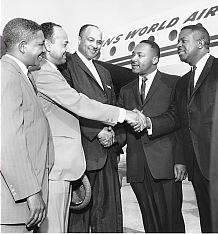 |
 |
 |
 |
|
|
|
Fort Wayne visit
Dr. Martin Luther King is shown in his 1963 visit to Fort Wayne. Greeting him were, from left, City Councilman John Nuckols, Dr. Allen Wilson and the Rev. Clyde Adams. At right is the Rev. Ralph D. Abernathy, who succeeded Dr. King as head of the Southern Christian Leadership Council.
|
|
|